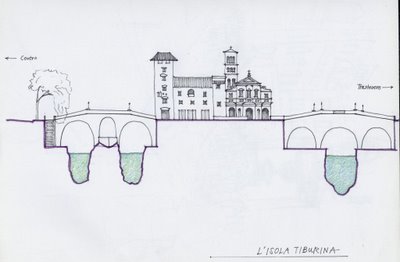
Here is a map that I made that shows where I live - Piazzale Clodio up at the top - and the buses that leave from that station. I take the #23 (red) to work, and #70 when I don't want to walk home from the Centro.
Yesterday I went to the third of the four Rome city museums. This one is not mentioned in any of my 3 tourist books, and a Google query yielded the advice "for serious academics only", so I wasn't sure what to expect. But, as you know, I want to take advantage of my free entry as much as possible.
To re-cap, here are the 4 main city of Rome museums:
Palazzo Altemps - thumbs up! It's close to Piazza Navona, has great statues in a fantastic palace, and it's just the right size (not too big).
Palazzo Massimo - thumbs down! In a city of hundreds of museums, this is one you can skip. The statues and artifacts aren't as interesting as in the other museums in town.
Terme di Diocleziano - The Baths of Diocletion (this doesn't look right but I'm not sure how to spell it in English). I haven't been to this yet.
Crypta Balbi - thumbs up - but only if you are interested in buildings and history! The Crypta Balbi is the story of one city block in Rome over the last 2000+ years. It is an ongoing archelogical site, so when you enter the building at street level, you are in a 2-story space with a large ancient wall in front of you. There are openings in the floor through which you can look down a few more stories at stone walls and foundations.
The main wall of the museum is one small remaining part of the Crypta Balbi, built around 13 BC. The Crypta was a huge complex - a large, rectangular courtyard with interior colonade in a rectangular building. To one end, a semi-circular theatre was appended.
The story of the museum is how this city block changed throughout history. In the imperial era, there was a row of temples to one side. The foundations and portions of the central wall were extended in the Middle Ages, churches and convents came and went, and parts of the museum building itself were constructed in the last few decades. As I've mentioned before, the street level of Rome has gotten higher and higher as time goes by, so the deeper you dig, the older stuff you find.
I especially liked the contemporary museum design and the way it worked around all of the in-situ archeology. Highly recommended (again, if you're into buildings and history).
Happy birthday to my father today!



